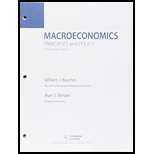
To describe: The four main components of aggregate
Answer to Problem 1TY
Four main components are consumption, investment, Government expenditure and net exports.
Largest component is consumption expenditure and the smallest one is net exports.
Explanation of Solution
The four main components are as follows:
Consumption: It can be stated as the spending for purchasing goods and services. It always depends positively on the disposable income and depends on the size of income and marginal propensity to consume. The consumption will be greater when the disposable income is greater.
Investment : It is to enhance the productivity by adding to the existing capital. It can be machinery, payment for additional labor, addition of stock capital, etc.
Government expenditure : This includes the purchase of goods and services by government at a point of time and is denoted by G.
Net exports: It can be defined as the difference between imports and exports. The money value will be more when exports are greater than the imports and vice versa.
The aggregate demand can be calculated by the equation.
From the above equation, it is clear that the aggregate demand is the sum of consumption, investment, government expenditure and net exports.
The largest component is the consumption expenditure as it constitutes of two-third of the overall expenditure. While net exports is the smallest component as it is the difference between the imports and exports, the value of this difference would be smaller
Introduction: Aggregate demand is an economic indicator of the overall demand for all finished goods and services produced in an economy. At a given price level and point in time, aggregate demand is defined as the cumulative amount of money traded for certain goods and services.
Want to see more full solutions like this?
Chapter 8 Solutions
MACROECONOMICS (LOOSELEAF)-PACKAGE
- As indicated in the attached image, U.S. earnings for high- and low-skill workers as measured by educational attainment began diverging in the 1980s. The remaining questions in this problem set use the model for the labor market developed in class to walk through potential explanations for this trend. 1. Assume that there are just two types of workers, low- and high-skill. As a result, there are two labor markets: supply and demand for low-skill workers and supply and demand for high-skill workers. Using two carefully drawn labor-market figures, show that an increase in the demand for high skill workers can explain an increase in the relative wage of high-skill workers. 2. Using the same assumptions as in the previous question, use two carefully drawn labor-market figures to show that an increase in the supply of low-skill workers can explain an increase in the relative wage of high-skill workers.arrow_forwardPublished in 1980, the book Free to Choose discusses how economists Milton Friedman and Rose Friedman proposed a one-sided view of the benefits of a voucher system. However, there are other economists who disagree about the potential effects of a voucher system.arrow_forwardThe following diagram illustrates the demand and marginal revenue curves facing a monopoly in an industry with no economies or diseconomies of scale. In the short and long run, MC = ATC. a. Calculate the values of profit, consumer surplus, and deadweight loss, and illustrate these on the graph. b. Repeat the calculations in part a, but now assume the monopoly is able to practice perfect price discrimination.arrow_forward
- how commond economies relate to principle Of Economics ?arrow_forwardCritically analyse the five (5) characteristics of Ubuntu and provide examples of how they apply to the National Health Insurance (NHI) in South Africa.arrow_forwardCritically analyse the five (5) characteristics of Ubuntu and provide examples of how they apply to the National Health Insurance (NHI) in South Africa.arrow_forward
 Economics Today and Tomorrow, Student EditionEconomicsISBN:9780078747663Author:McGraw-HillPublisher:Glencoe/McGraw-Hill School Pub Co
Economics Today and Tomorrow, Student EditionEconomicsISBN:9780078747663Author:McGraw-HillPublisher:Glencoe/McGraw-Hill School Pub Co
 Economics (MindTap Course List)EconomicsISBN:9781337617383Author:Roger A. ArnoldPublisher:Cengage Learning
Economics (MindTap Course List)EconomicsISBN:9781337617383Author:Roger A. ArnoldPublisher:Cengage Learning

 Exploring EconomicsEconomicsISBN:9781544336329Author:Robert L. SextonPublisher:SAGE Publications, Inc
Exploring EconomicsEconomicsISBN:9781544336329Author:Robert L. SextonPublisher:SAGE Publications, Inc





